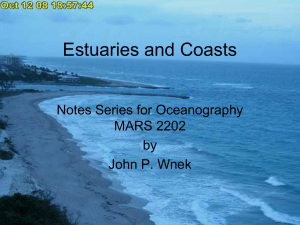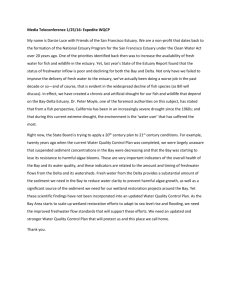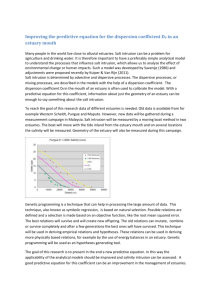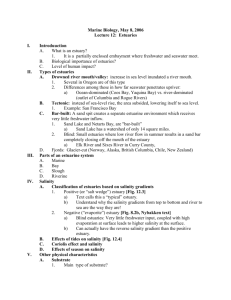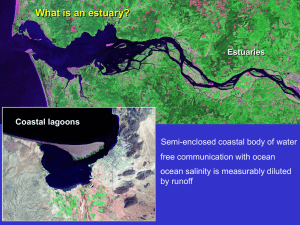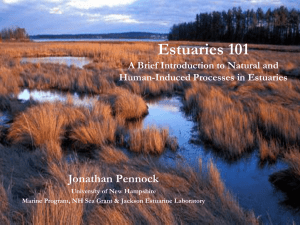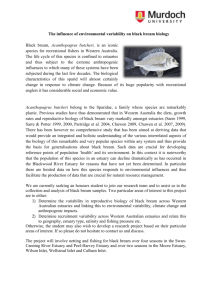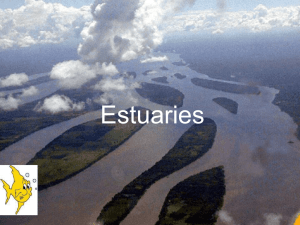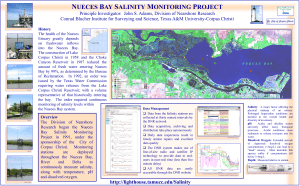Global Climatic Change and Sea Level Rise
advertisement
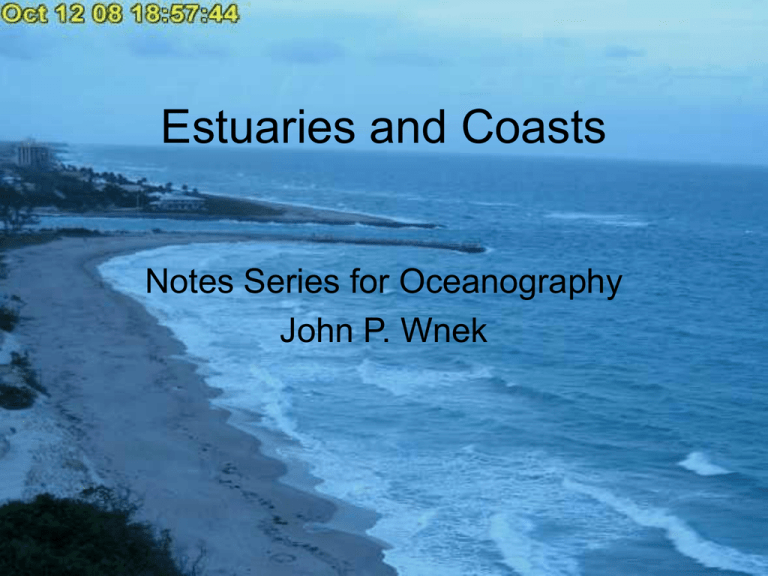
Estuaries and Coasts Notes Series for Oceanography John P. Wnek Coastlines and Productivity oceanworld.tamu.edu Coastal diagram with the area of nearshore and offshore productivity Beaches http://www.usa-chamber.com/gulf-beaches/home.html High Productivity Coastal Areas from NASA (SeaWIFS) Northeast Coast Habitats /www.epa.gov/owow/estuaries/programs/se.htm Estuary Types: Classified by Geology • Lagoon – parallel to coast (i.e. Indian River Lagoon, Florida) – Bar-Built Estuaries • Coast Plain Estuary – erosion (i.e. Chesapeake Bay and Pamlico Sound) • Tectonic Estuary – faults (i.e. San Francisco Bay) • Fjord – glacier formation (i.e. Alaska, British Columbia, Norway, Chile)\ • Delta- formed at mouth of a river (i.e. – Mississippi Delta) Coastal Types Rocky Coasts Western Coasts U.S. Mountain Coasts Northern Boreal Coasts Barrier Island Coast Sandy Hook, N.J. San Francisco Bay Estuary – a tectonic estuary Basic Definition of Estuary – A water body where salt & freshwater mix Technical Definition - “A standing water body within the coastal region where there is a greater net inflow of freshwater than an influx of sea water” J Wnek Factors influencing an estuary • Temperature • Salinity • Nutrients Anthropogenic effects • Increased runoff • Development causing habitat fragmentation • Global Climatic Changes Temperature • Highly subjected to seasonal variations • Shallow estuaries are prone to wide ranges in temperatures (i.e. Barnegat Bay) with variations from below -2 to 30 oC • Temperatures may change with shifting tidal regimes • There can be temperature inversions during the evenings, especially in the fall when cooler temperatures may be at the surface. http://waterdata.usgs.gov/usa/nwis/uv?site_no=01409125 Salinity • Salinity can vary in estuaries based upon the amount of salt water inflow and freshwater inputs. • Estuaries can be classified according to the layering of salt water based on density - well-mixed - partially-mixed - salt wedge (highly stratified) Inverse Estuaries • Some estuaries show an increase in salinity over time, these are considered “inverse estuaries” or “negative estuaries.” • There is a net increase in salinity over time mostly due to human impacts (i.e. dams and loss of freshwater flow into the system) (Zedler et al. 2001) Swan River Estuary, W. Australia (Neira et al., 1992) “Human activities have greatly increased the delivery of plant nutrients to estuarine and coastal waters throughout the world. Over abundant nutrients fuel excessive algal growth, which destroys critical habitats for fish and shellfish by depleting oxygen in the water and by blocking light from reaching sea grasses.” - Smithsonian Environmental Research Center Flushing Time? • Considered the amount of time in which all water is totally exchanged in an estuary • Varies according to the estuary due to ocean access, freshwater runoff (called inflow) and depth of the estuary tF = VF / R tF is the flushing time Vf is the freshwater volume R is the river discharge rate Flushing Time* Comparisons Estuary Minimum Maximum Mean Chesapeake Bay, MD-VA 210 days (Guo) Delaware Bay, DE-NJ 100 days (Delaware Estuary Program) Barnegat Bay, NJ 24 days (January 1995) 74 days (June/July 1995) 49 days (Guo) North River, MA 3 days (Geyer) 9 days (Geyer) Not determined Estuaries as Habitats • Estuaries provide multiple habitat types including marshes, marsh pools, tidal creeks, and shoreline deep water habitats • Finfish can inhabit specific habitats with fish being considered seasonal residents (19%), residents (21%) , nursery (38%) or strays (22%) in a study on Great Bay and Little Egg Harbor (Able et al. 1996 in Estuarine Shores). Marsh Zonation • High Marsh – Not flooded regularly with predominant Spartina patens and Phragmites – Series of marsh pools at higher elevations • Low Marsh – Floods regularly with Spartina alterniflora – Creeks and ditches with sometimes tidal effects – Support a higher density of finfish than SAV beds (Sogard and Able 1991). Marsh Zones (Jones and Strange 2006) Submerged Aquatic Vegetation •In some estuaries over 300 species of fish reside all in which SAV is important: •Provide habitat for juveniles •Key source of oxygen production •Important part of nutrient cycling •Binds and stabilizes sediments Data from the CRSS and Barnegat Bay Estuary Program 2001 Species and habitats Sygnathus fuscus Cyrpinodon variegatus Three-spine stickleback Gasterostreus aculeatus Striped Bass (Morone saxatilis) www.stripertracker.org Anthropogenic Effects on Coastlines Coastal erosion in Norfolk in 1997 Human Impacts and Changes in Estuaries Delaware Bay and human impacts In the past eighteen thousand years, sea level has risen one hundred meters (three hundred feet), converting freshwater rivers into brackish estuaries (Donn, Farrand, and Ewing 1962). The Delaware River is an Alluvial Plain Delaware River Fluxes in Sea Level Rise Hull, C.H.J. and J.G.Titus (eds). 1997. Greenhouse Effect, Sea Level Rise, and Salinity in the Delaware Estuary.. Washington, D.C.: U.S. Environmental Protection Agency and Delaware River Basin Commission. Marsh Systems Hartig et al. 2002 Hartig et al. 2002 Proposed Bruun Model with changing sea level Shifting of dunes and berms in response to sea level rise Davidson-Arnott, R. 2005. Conceptual model of the effects of sea level rise on sandy coasts. Journal of Coastal Research 21 (6): pp. 1166-1172. Jones & Strange 2006 Jones & Strange 2006 Jones & Strange 2006 Habitat Alteration Models from Jones and Strange 2006 SAV model (blue 3 mm/ red 9 mm) Phrag. model (blue 3 mm/ red 9 mm) Based on the inundation model through 2195 Habitat Alteration Models from Jones and Strange 2006 S. alterniflora model (blue 3 mm/ red 9 mm) S. patens model (blue 3 mm/ red 9 mm) Based on the inundation model through 2195 References Able, K, D.A. Witting, R. McBride, R. Rountree, and K.J. Smith. 1996. Fishes of polyhaline estuarine shores in Great Bay-Little Egg Harbor, New Jersey: a case study of seasonal and habitat influences in Estuarine Shores by K.F. Nordstrom and C.T. Roman (eds.). John Wiley and Sons, England: pp. 335-353. Candolin, U., T. Salesto, and M. Evers. Changed environmental conditions weaken sexual selection in sticklebacks. 2006. The Authors: Journal Compilation in the European Society for Evolutionary Biology 20: pp. 233- 239. Carlson, D.M., and R.A. Daniels. 2004. Status of Fishes in New York: Increases, Declines, and Homogenization of Watersheds. American Midland Naturalist 152: pp. 104-139. Davidson-Arnott, R. 2005. Conceptual model of the effects of sea level rise on sandy coasts. Journal of Coastal Research 21 (6): pp. 1166-1172. Diffenbaugh, N.S., M.A. Snyder, and L.C. Sloan. 2004. Could CO2- induced land cover feedbacks alter nearshore upwelling regimes. Proceeding of the Natural Academy of Science, 101 (1): pp. 27-32. Dybas, C.L. 2006. On a Collision Course: Ocean Plankton and Climate Change. BioScience 56 (8): pp. 642646. Galbraith, H., R. Jones, J. Clough, S. Herrod-Julius, B. Harrington, and G. Page. 2002. Global Climatic Change and Sea Level Rise: Potential Losses of Intertidal Habitat for Shorebirds. Waterbirds 25 (2): pp. 173-183. Guo, Q., N. P. Psuty, G.P. Lordi, S. Glenn, and M.R. Mund.1995. Hydrographic Study of Barnegat Bay, Year 1: Volume 1 and 2. Prepared by the Rutgers the State University of New Jersey, New Brunswick, NJ, for the New Jersey Department of Environmental Protection, Division of Science and Research. Guo, Q. and Valle-Levinson. 2007. Tidal effects on estuarine circulation and outflow plume in the Chesapeake Bay. Continental Shelf Research 27: 20-42. References (cont’d) Gray, V.R., 1998. "The IPCC future projections: are they plausible". Climate Research 10 pp. 155-162 Green, R., J.E. Maldonado, S. Droege, and M.V. McDonald. 2006. Tidal Marshes: A Global Perspective on the Evolution and Conservation of their Terrestrial Vertebrates. BioScience 56 (8): pp. 675 – 685. Hartig, E.K., V. Gornitz, A. Kolker, F. Mushacke and D. Fallon. 2002. Athropogenic effects and climatechange impacts on salt marshes of Jamaica Bay, New York City. Wetlands 22 (1): pp. 71 – 89. Hull, C.H.J. and J.G.Titus (eds). 1997. Greenhouse Effect, Sea Level Rise, and Salinity in the Delaware Estuary.. Washington, D.C.: U.S. Environmental Protection Agency and Delaware River Basin Commission. Jones, R. and E. Strange. 2006. A Pilot Study of the Ecological Consequences of Human Responses to Sea Level Rise. Stratus Consulting Inc., Boulder Colorado as part of a supporting document for the Barnegat Bay National Estuary Program’s Conservation and Management Plan (item 4.1): pp. 1- 61. Neira, F.J., I.C. Potter, and J.S. Bradley. 1992. Seasonal and spatial changes in the larval fish fauna within a large, temperate Autralian estuary. Marine Biology 112: 1- 16. Ogdon, J., S.M. Davis, T.K. Barnes, K.J. Jacobs, and J.H. Gentile. 2005. Total System Conceptual Ecological Model. Wetlands 25 (4): 955-979. Reed, D.J., D.A. Bishara, D.R. Cahoon, J. Donnelly, M. Kearney, A.S. Kolker, L.L. Leonard, R.A. Orson, and J.C. Stevenson. 2006. Site-specific scenarios for wetlands accretion as sea level rises in Mid-Atlantic Region. Supporting document for CCSP 4.1 to Climatic Change Division U.S. Environmental Protection Agency: pp. 1- 54. Zedler, J.B. 2005. Restoring wetland plant diversity: a comparison of existing and adaptive approaches. Wetlands Ecology and Management 13: 5-14.
